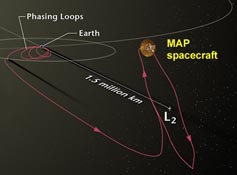
The Microwave Anisotropy Probe took a convoluted path to reach its observing post at the L2 Lagrangian point, 1.5 million kilometers from Earth.
Courtesy MAP/NASA.
Three months ago NASA launched its newest astrophysics satellite, the Microwave Anisotropy Probe (MAP), from Cape Canaveral, Florida. After circling Earth three times and getting a gravity boost from the Moon, the craft is finally positioned to begin its observations.
MAP will have the advantage of observing from near the L2 Lagrangian point, a location suspended 1.5 million kilometers above local midnight on Earth. From there, looking outward into space with its view unobstructed by the Earth, Moon, or Sun, the craft will take readings over the whole sky every six months.
Built at the NASA/Goddard Space Flight Center, MAP will continue the work of the Cosmic Background Explorer (COBE) satellite in studying the 3°K cosmic background radiation left over from the Big Bang. But while instruments on COBE only had an angular resolution of 7°, MAP will detect features as small as 13 arcminutes — and it will discern temperature variations of as little as 0.00002°. Such tiny differences correspond to structures in the early universe that grew by gravitational collapse into the galaxies and superclusters of the present day. The MAP science team predicts that its first all-sky maps will be available in December 2002.
 0
0
Comments
You must be logged in to post a comment.